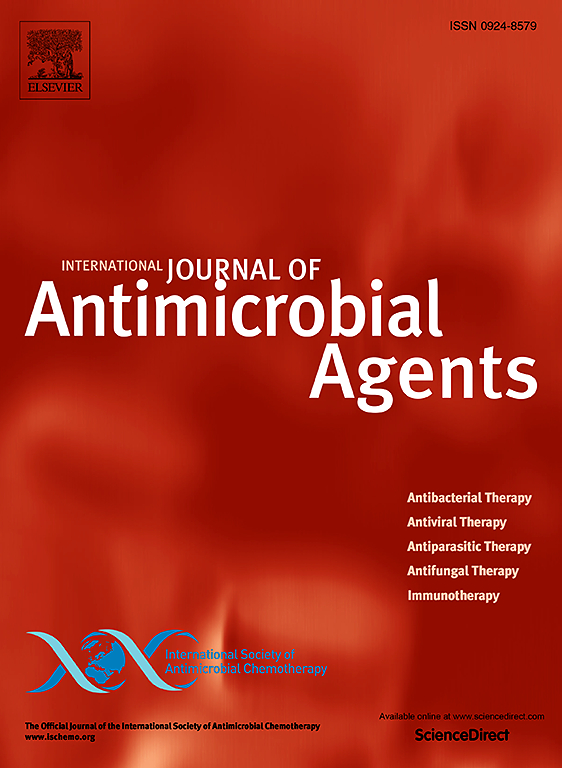Ceftriaxone population pharmacokinetics in plasma and cerebrospinal fluid of neurocritical care patients
IF 4.9
2区 医学
Q1 INFECTIOUS DISEASES
International Journal of Antimicrobial Agents
Pub Date : 2025-02-07
DOI:10.1016/j.ijantimicag.2025.107461
引用次数: 0
Abstract
Background
Patient outcomes during ventriculitis may be improved by antibiotic dose optimisation strategies that increase the achievement of therapeutic concentrations at the infection site. We performed a population pharmacokinetic (PK) study in neurocritical care patients to define ceftriaxone dosing regimens required to achieve effective cerebrospinal fluid (CSF) exposures.
Methods
Patients receiving ceftriaxone for treatment of ventriculitis or extracerebral infections or for prophylaxis following external ventricular drain insertion were recruited and subject to serial plasma and CSF sampling. Population PK modeling and dosing simulations to achieve the following plasma targets: (a) unbound ceftriaxone concentration above pathogen minimum inhibitory concentration over the dosing interval (100% fT>MIC) and (b) unbound ceftriaxone concentration at least fourfold above pathogen minimum inhibitory concentration over the dosing interval (100% fT>4×MIC), were performed.
Results
Ten patients were recruited; median age, weight, and creatinine clearance were 57 years, 60 kg, and 107 mL/min/1.73m2, respectively. Ceftriaxone PK displayed considerable variability, especially in CSF, with between subject variability ranging from 21% to 794%. Median total ceftriaxone CSF penetration was 1.43% (range 0.33–8.42). Intermittent infusions of 2 g every 8 hours achieved 99.5% and 82% probability of attaining 100% fT>MIC and fT>4×MIC in plasma for an MIC of 1 mg/L, respectively. The model was unable to accurately predict ceftriaxone concentrations in CSF, precluding CSF dosing simulations.
Conclusions
High attainment of plasma target exposures was achieved with higher than standard dosing. Dosing recommendations to optimise targeted CSF ceftriaxone exposures for treatment of ventriculitis could not be made given inadequate model predictability.
头孢曲松在神经危重症患者血浆和脑脊液中的药代动力学。
在脑室炎期间,患者的预后可以通过抗生素剂量优化策略来改善,这种策略可以增加感染部位的治疗浓度。我们对神经危重症患者进行了人群药代动力学(PK)研究,以确定实现有效脑脊液(CSF)暴露所需的头孢曲松剂量方案。招募接受头孢曲松治疗脑室炎或脑外感染或脑室外引流管插入后预防的患者,并对其进行连续血浆和脑脊液取样。种群PK建模和给药模拟,以实现以下血浆目标:(a)未结合头孢曲松浓度高于给药间隔内病原体最低抑制浓度(100% fT> 0 MIC)和(b)未结合头孢曲松浓度至少高于给药间隔内病原体最低抑制浓度四倍(100% fT>4×MIC)。招募了10名患者;中位年龄、体重和肌酐清除率分别为57岁、60 kg和107 mL/min/1.73m2。头孢曲松PK表现出相当大的可变性,特别是在脑脊液中,受试者之间的可变性范围为21-794%。头孢曲松CSF穿透中位数为1.43%(范围0.33-8.42)。当MIC为1 mg/L时,每8小时间断输注2g,血浆中达到100% fT>MIC和100% fT>4×MIC的概率分别为99.5%和82%。该模型无法准确预测脑脊液中头孢曲松的浓度,因此无法进行脑脊液给药模拟。在高于标准剂量的情况下,获得了较高的血浆靶照射。由于模型可预测性不足,无法提出优化脑脊液靶向头孢曲松暴露治疗脑室炎的剂量建议。
本文章由计算机程序翻译,如有差异,请以英文原文为准。
求助全文
约1分钟内获得全文
求助全文
来源期刊
CiteScore
21.60
自引率
0.90%
发文量
176
审稿时长
36 days
期刊介绍:
The International Journal of Antimicrobial Agents is a peer-reviewed publication offering comprehensive and current reference information on the physical, pharmacological, in vitro, and clinical properties of individual antimicrobial agents, covering antiviral, antiparasitic, antibacterial, and antifungal agents. The journal not only communicates new trends and developments through authoritative review articles but also addresses the critical issue of antimicrobial resistance, both in hospital and community settings. Published content includes solicited reviews by leading experts and high-quality original research papers in the specified fields.

 求助内容:
求助内容: 应助结果提醒方式:
应助结果提醒方式:


